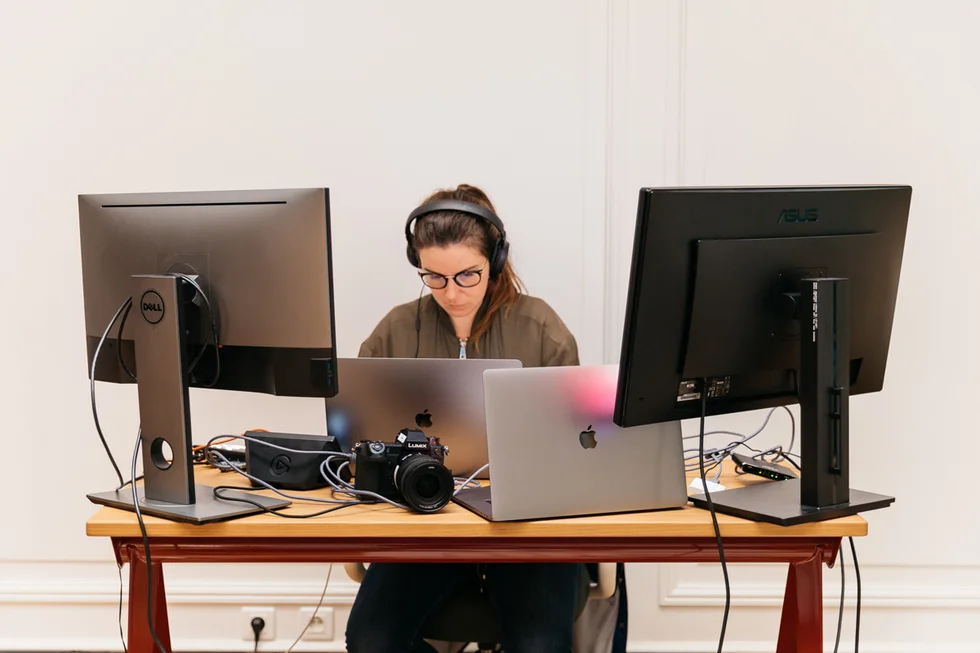Digital eye strain: You are not alone
Oct 04, 2022
5 mins

JB
Writer, translator and journalist
How many times have you finished work with a headache, watery eyes, neck strain – or all of the above? You might be surprised to hear that this may be down to a condition called computer vision syndrome (CVS), which is also known as digital eye strain, and is brought on by prolonged screen use. You’re probably not surprised, however, to hear that its prevalence has shot up since the beginning of the pandemic, though it has only begun to be taken seriously as a medical issue in recent years.
The average American now spends more than seven hours a day on the internet – meaning that some people spend more time looking at a screen than they do sleeping. This may seem like nothing to worry about, but an increasing body of research is starting to show that prolonged screen time can have a serious impact on our eyesight, and our ability to work effectively.
It is a growing problem too, according to Dr Amy Sheppard, a senior lecturer at one of the world’s leading research centers into CVS, the Optometry School at Aston University in the UK. “Before the pandemic, limited studies in the area showed that around 50% of people were experiencing unpleasant CVS symptoms. However, since the pandemic, more recent studies have indicated this may be over 80%,” she says.
The symptoms of digital eye strain include dry eyes, blurred vision, neck and shoulder pain, headaches and gritty eyes, among others. These symptoms tend to have a negative impact on productivity as they can lead to “lower concentration, less ability to focus on tasks and ultimately workers making more mistakes,” says Sheppard.
What you can do
Given how much time most of us spend on our screens, it may seem that CVS is inevitable. That’s not necessarily true and there are steps we can take to ease the problem, according to Dr Christine Sindt, a clinical professor of ophthalmology and visual sciences at Carver College of Medicine, which is part of the University of Iowa Health Care.
One way to alleviate symptoms is to implement the 20-20-20 rule when working with a screen. This means that every 20 minutes, you should focus on something 20 feet away for at least 20 seconds. Sindt says it’s important for our eyes to have a variety of visual activities so that we’re not constantly focusing on things close-up. “Taking breaks and looking far away helps relax our visual system,” she says.
Sheppard adds that lighting plays a role too. Ideally the screen’s lighting should not be very different from that in the room. The screen should not be too bright and the room should have lots of natural light. Always aim to position the devices so that there isn’t any glare or reflection on the screen. Reflections cause “discomfort glare, which makes us squint and which in turn creates discomfort.”
Another way of reducing CVS is to ensure that the screen is at the correct height. “Our eyes are not very good at reading while looking at something above eye level,” she says. “Therefore, you want the top of the screen to be at eye level or below.” Using a laptop can be beneficial for the eyes as they tend to be lower down and this facilitates our ability to blink, she adds, though there is a catch as we tend to adopt bad posture when using a laptop.
Sindt agrees. “When we’re looking in downgaze, we tend to tip our heads down and hunch over to create a posture which is visually more comfortable,” she says. This posture can contribute to neck strain.
Remember to blink
One of the key issues of using screens is how they affect our ability to blink. Scientists still don’t fully understand why this is the case, according to Sheppard, but there is evidence to suggest that our eyes respond differently to a digital screen than to a piece of paper. Sheppard adds that this may simply be down to the fact that we are spending hours doing things that just didn’t exist before, such as scrolling on social media or poring over spreadsheets.
Blinking is vital, though. Sindt says, “Our eyelids are like windshield wipers on a car. Therefore, when our blink rate goes down, just like a car window gets dirty, our visual world does too.” When we blink less, our eyes start to dry out more and our vision starts to become blurry, she says, adding that it’s important to take visual breaks as doing so alters your blinking and helps to refresh the ocular surface. It can be easy to forget to take breaks, but technology may be starting to provide a solution.
Tech can help too
An increasing number of apps and digital solutions are being developed to help protect our eyesight and reduce the effects of digital eye strain. One of these is Blink, an app built by Indian developer Pallab Gogoi, which reminds people to blink consciously when using screens. It is a simple solution but one that has been well-received by users who suffer from the condition.
Gogoi started to build the app in 2020 after suffering from watery eyes to such an extent that at times it drew attention from others.“People would ask me if I was crying or sad,” he says. Despite visiting an ophthalmologist and various attempts to use medication, his symptoms failed to improve. So he set about researching the causes of the condition and came across a video of an ophthalmologist that explained how screens cause us to forget to blink, which in turn amplifies the effects of tearfulness. “This was true for me, because I am an app developer and stare at screens for hours on end,” he says. “I discovered that a simple way to keep it under control was blinking often.” That is when Gogoi had his lightbulb moment.
Blink can be installed on devices and features a small eye on the screen that blinks periodically in order to remind users to do so too. By using his own app, Gogoi found his symptoms improved. Gogoi says he wasn’t sure whether other people were looking for such an app. Once the app went live, however, he saw the positive effect it had on others and he received emails thanking him for creating it. Digital eye strain is a universal issue, he says.
Visit an optician
Ultimately, though, one of the best ways to combat CVS, according to both Sheppard and Sindt, is to get your eyes tested regularly by an optician and to seek professional advice from a trained optometrist. “Years ago, opticians might have said that someone didn’t need glasses, but nowadays, people with even low prescriptions may benefit from wearing specs. Particularly if they’re working on devices a lot,” Sheppard says. It’s important to wear the correct prescription glasses and to get even low levels of astigmatism corrected too.
Sindt advises talking to your optometrist about your job and what type of devices you work on, so that they can advise you on different options suitable for you. “Getting your eyes tested is probably the most helpful thing that an individual can do,” Sheppard says.
Getting to the nitty gritty
For a condition that is so widespread and on the increase, there is “a lot that’s not known,” according to Sheppard. Before the pandemic, there wasn’t a lot of interest in the issue but that has changed as more and more people have begun to suffer from it. She says this is helpful as “there will be a lot more really good quality science and publications in the short to medium term.” This is important because, as Sindt says, “We haven’t gone through an entire generation of working on a computer. We have to see how this plays out through populations.”
As our working lives become more dominated by screens, we can expect digital eye strain to become more common. In the meantime, we can all benefit from taking a visual break, getting our eyes tested and most importantly blinking. Happy blinking!
Photo: Welcome to the Jungle
Follow Welcome to the Jungle on Facebook, LinkedIn, and Instagram, and subscribe to our newsletter to get our latest articles every day!

More inspiration: Physical health

Navigating your career while managing chronic illness
Struggling to juggle work and chronic illness? Learn how to create a supportive career path and find solutions.
Dec 24, 2024

The best equipment to help you get exercise without leaving your desk
A sedentary lifestyle can lead to serious health problems. So, how can you stay fit while still at your desk?
Nov 09, 2023

Glued to your desk all day? Try these discreet exercises
Laptop-based work can mean freedom and comfort, but a sedentary lifestyle also brings a host of health risks...
Oct 18, 2023

How the world of work is getting better for veterinarians
Though typically not considered a dangerous profession, veterinary services rank among the highest industries for non-fatal injuries
Oct 04, 2023

The dynamic benefits of walking meetings
As our jobs become more flexible, workers are finding new ways to improve their mental and physical health
Oct 03, 2023
The newsletter that does the job
Want to keep up with the latest articles? Twice a week you can receive stories, jobs, and tips in your inbox.

Looking for your next job?
Over 200,000 people have found a job with Welcome to the Jungle.
Explore jobs